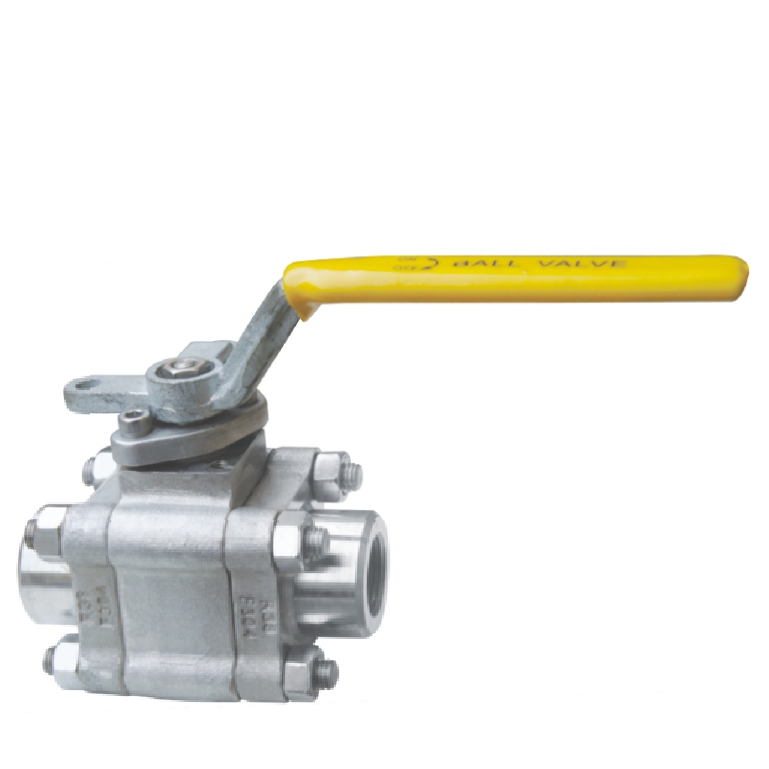A three piece forged hard sealed ball valve typically consists of three main parts: valve body, valve cover, and ball body. This design feature makes maintenance and repair relatively easy. Operators can separate these parts to inspect and maintain the interior of the valve without disassembling the entire valve. This reduces downtime and maintenance costs, and improves operational efficiency. The valve body made by forging can withstand greater pressure and have more stable performance. The metal seal can withstand high temperatures, and the connection methods mainly include threading, butt welding, and socket welding.

Performance characteristics
1. The ball and valve seat are sprayed with supersonic flame spraying technology, spraying superhard chromium carbide or tungsten carbide alloy on the sealing surface of the valve, so that the surface hardness of the ball and valve seat can reach up to Rockwell HRC65. Moreover, the thermal expansion coefficient of the coating and the ball is the same, and it will not peel off when the medium temperature changes greatly. We can also replace the spray coating materials according to customer requirements, including Cr based alloys, Ni based alloys, Babbitt alloys, ceramics, etc. 2. The ball and valve seat are equipped with advanced grinding machines, and industrial diamond powder is used for one-on-one grinding, making the sealing surface 100% perfectly matched. 3. Suitable for high temperature, high pressure, anti-corrosion, media containing particulate matter, fibrous substances, dust, and high viscosity media, effectively shearing and removing any particles and substances on the surface of the sphere, and quickly cutting and controlling the media. 4. Ultra resistant to wear, high temperature (90-800 degrees), erosion, corrosion (salt corrosion, acid corrosion, alkali corrosion, etc.), high pressure (6.4Mpa-42.0Mpa). 5. Suitable for petroleum, chemical, petrochemical, metallurgical, light industry, refining, power plants, food, medicine, papermaking, minerals, etc. 6. Suitable for freshwater, sewage, seawater, air, steam, food, medicine, chemical preparations, various oils, acids, bases and salts, etc.
standard specification
1. Design and production: GB/T 12237
2. Valve body thickness: GB/T 122243. NPT Threaded Connections: ASME B1.20.1; G-threaded connection: GB/T 12716; RC threaded connection: GB/T7306.2
4. Socket welding: ASME B16.11
5.[UNK]焊ASME B16.25ASME B36.10M
6. Inspection and testing: API598
Design specification 1. Handle with locking device to prevent incorrect operation, safer and more reliable; 2. Prevent the valve stem from blowing out; 3. Convenient operation; 4. According to API607 standard, fire protection design; 5. There is an anti-static device between the valve stem and the sphere; 6. Connection end: NPT thread, socket welding, butt welding (valve body can be extended).
Three piece forged hard sealed ball valves are usually manufactured using forging technology, and stainless steel or other high-strength alloys are commonly used as materials. These materials have excellent mechanical properties and are particularly suitable for environments with high temperature, high pressure, and corrosive media. The forging process makes the material stronger and increases its durability, making it suitable for various harsh working conditions.
The design of the three piece forged hard seal ball valve is very engineer and operator friendly. It usually consists of three main parts: valve body, valve cover, and ball. This design feature makes maintenance and repair relatively easy. Operators can separate these parts to inspect and maintain the interior of the valve without disassembling the entire valve. This reduces downtime and maintenance costs, and improves operational efficiency.
The working principle of the three piece forged hard seal ball valve is relatively simple, but efficient. There is a sphere inside the valve, usually with a hole or channel, which can be rotated to control the flow of fluid. When the holes of the sphere align with the pipeline, fluid can flow freely. On the contrary, when the sphere rotates to the closed position, the channel will be blocked, stopping the flow of fluid. This design allows the valve to quickly respond to opening and closing commands while providing precise flow control.